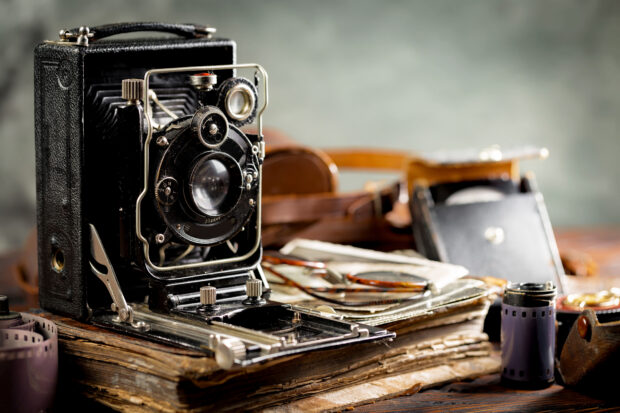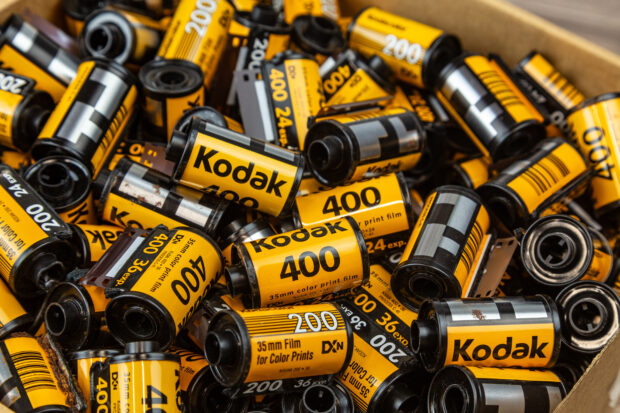Photography has transformed our world - not just culturally, but through the innovations and intellectual property (IP) rights that made it possible. We’re looking at the history of photography through an IP lens, from 400BC to modern day snaps.

The dawn of photography
Photography's story begins with the simple pinhole camera, documented as early as 400BC in China. However, it wasn't until the 1820s that Joseph Niépce and Louis Daguerre developed the first method to permanently capture images using photographic plates.
By 1837, Daguerre had perfected his process, creating the famous Boulevard du Temple photograph – thought to be the first image to capture a human figure. The long exposure time of 10-15 minutes meant only a man having his shoes shined stayed still enough to register on the image.
Interestingly, Daguerre chose not to patent his invention in the traditional way. Instead, the French government acquired the rights in exchange for lifetime pensions, presenting the daguerreotype process as a "gift to the world" in 1839. However, five days earlier, a patent had been filed in England (Patent No. 8194 of 1839), making the UK the only place where a licence was required to make daguerreotypes.
The first "selfie" and mass market photography
Interestingly, the first "selfie" was taken in 1839 by American lamp-maker Robert Cornelius. This early self-portrait demonstrates how quickly photography moved from scientific curiosity to personal expression.

The real transformation came in 1888 when Eastman's Kodak camera entered the market with the revolutionary slogan "You press the button, we do the rest." This simple promise changed everything. Photography was no longer the domain of specialists - anyone could capture a moment and leave the complex processing to others. The introduction of the Kodak Brownie in 1901 made photography truly accessible to the masses, sparking widespread adoption that would fundamentally change how we document our lives.
Revolutionary developments
William Henry Fox Talbot's contribution proved equally significant. His negative-positive process, patented as the "Calotype" in 1841, became the standard method for making photographs for the next 160 years. Talbot understood the commercial value of his innovation, selling licences across England, France, and America.
The Leica camera, introduced in 1925, revolutionised portable photography. Developed by Oskar Barnack and protected by German patent No. 384071, it popularised 35mm film photography and became synonymous with street photography legends like Henri Cartier-Bresson.
The colour revolution
In 1936, Kodak released Kodachrome, the first practical colour transparency film. Invented by high school musicians Leopold Godowsky Jr. and Leopold Mannes, who patented their colour process before graduation, Kodachrome triggered a cultural and commercial revolution in photography.
Edwin Land's Polaroid camera (1948) represented another breakthrough. Inspired by his daughter's question about why photos couldn't be seen immediately after taking them, Land developed instant photography, protected by US Patent 2543181. The first 57 Land Cameras sold out on their launch day.

The digital age
Steven Sasson's 1975 invention at Eastman Kodak – the world's first digital camera – fundamentally changed photography forever. Though initially the size of a toaster, his patented innovation (U.S. 4131919) laid the foundation for today's digital imaging industry. The Economist later called digital cameras a "seismic disruption" that rendered existing technology virtually obsolete.
Photography's cultural revolution
Photography's impact extended far beyond technical innovation into the realm of cultural transformation. War photographers like Roger Fenton, who documented the Crimean War, and Robert Capa, who captured D-Day, showed the public the reality of conflict for the first time. These images didn't just record history - they shaped public opinion and understanding of world events.
Perhaps nowhere was photography's cultural influence more dramatic than in the phenomenon of "Tutmania." When photographer Henry Burton documented the discovery of King Tutankhamun's tomb in the 1920s, his images ignited global fascination. The photographs, showing the gradual uncovering of treasures, made front-page news worldwide and sparked a cultural revolution that influenced Art Deco architecture, fashion, and design for decades. Sphinxes and papyrus columns began appearing on buildings, demonstrating how photographic documentation could trigger widespread cultural movements.

Innovation continues
Photography patents continue to drive innovation today. Established companies like Rollei developed fully automatic cameras with microprocessor control, distinguishing themselves in competitive markets through patented technology.
These innovations demonstrate how IP protection has been crucial to photography's development. Patents gave inventors the security to invest time and resources in research and experimentation. Trade marks protected brand identities, while registered designs secured distinctive visual elements.
Without IP protection, many photographic innovations might never have reached the public. The assurance that inventors could benefit from their creativity encouraged the risk-taking and investment necessary for breakthrough discoveries.
Looking forward
The journey from early cameras to smartphone photography demonstrates that innovation thrives when creators can protect their ideas. As photography continues evolving, intellectual property rights remain as important as ever in encouraging the next generation of photographic pioneers.
From those first permanent images captured nearly 200 years ago to today's instant digital world, photography's rich history shows how protecting innovation benefits everyone – creating not just better technology, but a more visually connected world.
Leave a comment